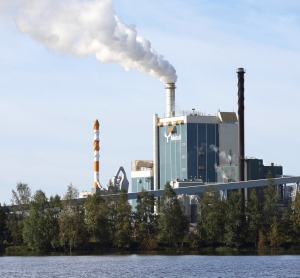
Metsä Fibre Starts Pre-Engineering for EUR 1.7 Billion Bioproducts Mill and Sawmill in Finland The new bioproduct mill will replace the current Kemi pulp mill (pictures above), which has an annual capacity of approximately 620,000 tonnes of sulphate pulp. The new mill is expected to have an annual production capacity of about 1.5 million tonnes of softwood and hardwood pulp.
The new bioproduct mill will replace the current Kemi pulp mill (pictures above), which has an annual capacity of approximately 620,000 tonnes of sulphate pulp. The new mill is expected to have an annual production capacity of about 1.5 million tonnes of softwood and hardwood pulp.
April 29, 2019 - Metsä Fibre, part of Metsä Group, commences pre-engineering projects related to building a new bioproduct mill in Kemi and a new sawmill in Rauma, Finland. If implemented in full, the total value of the investments would amount to approximately EUR 1.7 billion during 2020 - 2023. The investments in Kemi and Rauma would increase Finland's annual income by approximately EUR 0.6 billion, exports by approximately EUR 0.7 billion, and the positive employment impact in the direct value chains would be roughly 2,000. The construction phases would generate a positive employment impact of approximately 11,500 person-years. Bioproduct Mill in KemiThe Kemi pulp mill related prefeasibility study, launched in May 2018, has been finalized. The study included two alternatives: (1) building a totally new bioproduct mill that would be clearly bigger in size than the current Kemi pulp mill, or (2) alternatively extending the life cycle of the current mill by modernizing several departments. In the study, the availability of wood raw material and the development potential of Kemi's industrial infrastructure and logistic connections were examined in particular. Building a new bioproduct mill in Kemi was chosen for future development. Target for the now initiated pre-engineering project is to create conditions for building a bioproduct mill with annual production capacity of approximately 1.5 million tonnes of softwood and hardwood pulp to Metsä Group's current mill site in Kemi. In addition to pulp, the mill would produce various other bioproducts. This mill would be the biggest wood processing unit in the Northern hemisphere. The new mill would replace the current Kemi pulp mill which annual capacity is approximately 620,000 tonnes. The total investment would amount to approximately EUR 1.5 billion. The annual pulpwood consumption of the new Kemi bioproduct mill would be approximately 7.6 million cubic meters, which is roughly 4.5 million cubic meters more compared to the consumption of the current mill. The aim is to source the pulpwood for the mill from Finland. Securing the wood sourcing for the mill requires further studies to maximize the share of domestic wood. The Kemi bioproduct mill would directly employ approximately 250 people and, in its entire direct value chain, roughly 2,500 people in total. There is an increase of 1,500 people compared to the current situation. The employment impact in the construction phase would be almost 10,000 person-years of which over half in Kemi. The main planning premises of the new mill include totally fossil free operations and 250 per cent self-sufficiency in electricity. The pulp production volumes would be sold to European and Asian customers as well as to Metsä Board's, also a part of Metsä Group, linerboard mill located at the same mill site in Kemi. The final investment decision related to Kemi bioproduct mill is expected to be made in summer 2020. Pine Sawmill in RamaMetsä Fibre commences also a pre-engineering project to build a pine sawmill at its mill site in Rauma. The estimated annual production of the sawmill would be approximately 750,000 cubic meters. The new sawmill would be the most modern and efficient unit in its field in the world. The level of technology and utilization of data will be raised clearly higher compared to current sawmills. The total investment would amount to approximately EUR 200 million. The new sawmill would directly employ approximately 100 people and, in its entire direct value chain roughly 500 people in total. The employment impact in the construction phase would be approximately 1,500 person-years. The sawmill's annual sawlog consumption would be approximately 1.5 million cubic meters. Wood for the sawmill is planned to be sources from Finland. The increased sawn timber volumes would be sold mainly to European and Asian customers. The final investment decision related to Rauma sawmill is expected to be made in early 2020. Securing wood sourcing, preconditions for smooth deliveries, development of world economy; and especially Asian economy, results of environmental impact assessments, environmental permits, development of financial markets and export financing as well as cooperation with several parties related to wood sourcing, logistics, town planning and permits will impact the final investment decisions. Ismo Nousiainen, CEO of Metsä Fibre, commented, "The 100 per cent utilisation of wood raw material is central to Metsä Group's unique bioproduct concept. Logs are used for sawn timber, plywood and LVL products, and pulpwood for pulp and other bioproducts. The global demand for pulp and sawn timber is growing. The bioproduct mill in Kemi and the next-generation sawmill in Rauma would enable significant growth in our business. "Logs are the raw material for the sawmill. The by-products of sawn timber production, bark and dust, are used for bioenergy and chips for pulp production. The pulp mill generates bioenergy, which is used by the sawmill and the excess is sold to the national grid. The sawmill investment would enable fossil free production in the entire Rauma mill integrate." Metsä Fibre is a leading producer of bioproducts and bioenergy. The company's pulp brand is Botnia and the sawn timber brand is Metsä Nordic Timber. Metsä Fibre produces pulp and other bioproducts at four mills in Finland: Joutseno, Kemi, Rauma and Äänekoski; and also has six sawmills: Kyrö, Lappeenranta, Merikarvia, Renko and Vilppula (in Finland) and in addition, Metsä Svir sawmill in Russia. To learn more, please visit: www.metsafibre.com. SOURCE: Metsä Fibre |